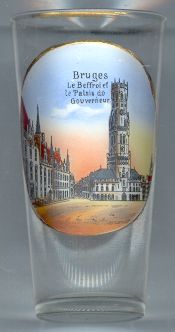

|
| BELGIË / BELGIQUE / BELGIEN | BELGIUM |
| gewest/région/Region: Vlaanderen / Flandre / Flandern | region: Flanders |
| provincie/province/Provinz: West-Vlaanderen / Flandre-Occidentale / West-Flandern | province: West Flanders |
fr: Bruges
| nl: Brugge
| de: Brügge
| |
 Brugge is the capital of the Belgian province of West Flanders and has a population of about 118,000.
The medieval town centre was listed in 2000 as a UNESCO World Cultural Heritage site
(see also list of other UNESCO heritage sites depicted on glasses of this collection)
and in 2002 shared the title of European Capital of Culture with Salamanca.
Brugge is the capital of the Belgian province of West Flanders and has a population of about 118,000.
The medieval town centre was listed in 2000 as a UNESCO World Cultural Heritage site
(see also list of other UNESCO heritage sites depicted on glasses of this collection)
and in 2002 shared the title of European Capital of Culture with Salamanca.
Brugge was founded in 892 by Boudewijn (Baudouin, 'With the Iron Arm'), the first Count of Flanders. The name (Bruggas or Bruccia in the 9th century) is derived from the Norman word 'bryggia' which means 'bridge' or 'jetty'. At that time brugge was still connected to the North Sea by a firth named Zwin. Due to this favourable location Brugge devloped into a flourishing trading town during the 11th century and also became was the seat of a branch office of the Hanse federation of trading towns. In 1128 Brugge was chartered as a town. The main source of income at that time was clothmaking. The name of the merchant's family Van der Beurze (documented in Brugge between 1257 and 1457) is probably the origin of the words for stock exchange in Dutch/Flemish ('beurs'), German ('Börse') and other languages; the family's crest showed three moneybags (lat.: 'bursa').
During the 15th century the town was ruled by the Dukes of Burgundy and towards the end of the Middle Ages Brugge was the richest town of Europe. Towards the end of the 15th century, however, the Zwin firth began to silt up which initiated the decline of Brugge. The Burgundy court moved out, Emperor Maximimilian I withdrew several of the privileges of the town, and eventually Brugge lost its leading position to Antwerp. During the times of the Spanish rule (1524–1713) the town even impoverished. After the Spanish Brugge was ruled by Austria (1713–1795), France (1795–1815), and the Netherlands (until 1830). Even the industrialisation of the 19th century did not improve the situation.
It took until 1892, when the Belgian author Georges Rodenbach published his famous novel 'Bruges la Morte', that Brugge again gained widespread awareness. The book has also been the basis for Erich Wolfgang Korngold's famous opera 'Die Tote Stadt', composed in 1917–1919. New economical perspectives were only opened in 1907 with a canal that connected Brugge with the North Sea port of Zeebrugge. Today the centuries-long period of economical stagnancy is the basis of a new flourishing period as the medieval town centre has remained unchanged as has become one of the best-known and most rewarding tourist places in Europe.
The  belfry (flem.: belfort, frech: beffroi, German Belfried) [background centre right] is a beloved landmark of Brugge.
The tower was built in 1240. After a fire in 1280 it was rebuilt in 1296. After another fire in 1741 it was again restored in 1751.
In 1822 the original spire which had topped the tower was replaced by a Gothic crown.
The tower has a height of 83 m and is accessible to the public (one has to climb 366 steps). It offers a breathtaking panoramic view over the city.
A carillon had been installed in the tower since the 16th century; in 1675 it consisted of 35 bells. After the fire of 1741 a new carillon
with 47 bells (total weight 26 tons) was installed. It is still in use today.
belfry (flem.: belfort, frech: beffroi, German Belfried) [background centre right] is a beloved landmark of Brugge.
The tower was built in 1240. After a fire in 1280 it was rebuilt in 1296. After another fire in 1741 it was again restored in 1751.
In 1822 the original spire which had topped the tower was replaced by a Gothic crown.
The tower has a height of 83 m and is accessible to the public (one has to climb 366 steps). It offers a breathtaking panoramic view over the city.
A carillon had been installed in the tower since the 16th century; in 1675 it consisted of 35 bells. After the fire of 1741 a new carillon
with 47 bells (total weight 26 tons) was installed. It is still in use today.
The  Provincial Court (Provinciaal Hof, Palais provincial) [far left] was built in Neo-Gothic style after a fire
in 1878 had destroyed a previous, Classicist, building. One part of the complex now is the seat of the governor of the province of West Flanders.
Provincial Court (Provinciaal Hof, Palais provincial) [far left] was built in Neo-Gothic style after a fire
in 1878 had destroyed a previous, Classicist, building. One part of the complex now is the seat of the governor of the province of West Flanders.
![[scale]](lineal.jpg)